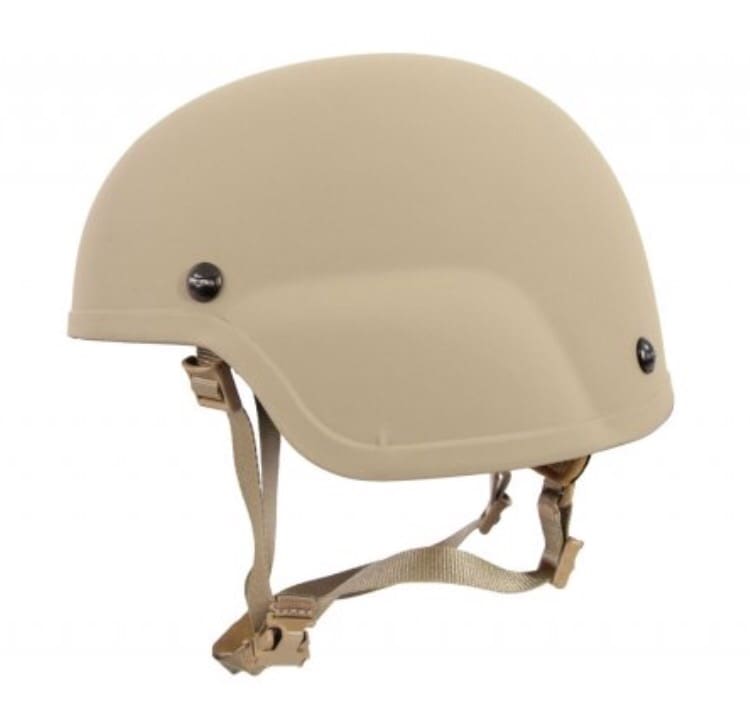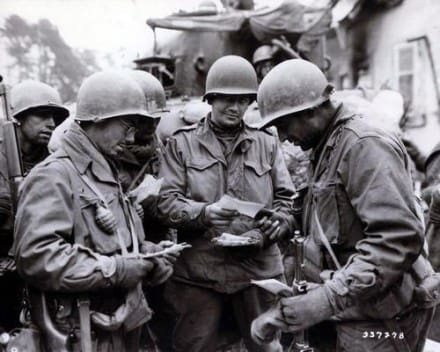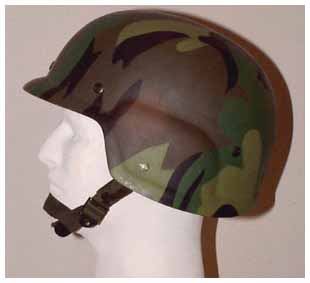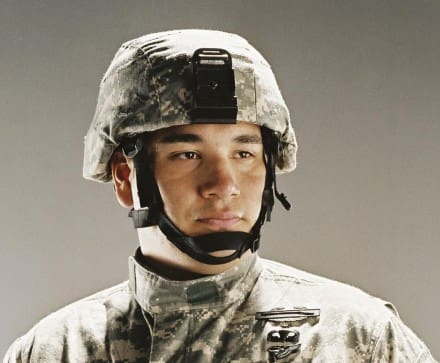PEO Soldier held a press conference earlier today regarding the Advanced Combat Helmet Gen II fielding. Officiating the event was LTC Kathy Brown, PM Soldier Protective Equipment. She was assisted by APM, MAJ Brandon Motte.
From World War II until the 1980s, the US military relied on a stamped steel helmet with liner, commonly referred to as the “Steel Pot”.
It was replaced by the Personal Armor System, Ground Troops or PASGT. Its nickname was the ‘Kevlar’ after the material it was made from.
In the late 1990s, USSOCOM began to take advantage of new para-Aramid materials and embarked on a program called the Modular Integrated Communications Helmet. The helmet’s design was modified slightly to a more streamlined shell than the bulky PASGT and it was quickly adopted by the US Army as the Advanced Combat Helmet, in the early 2000s as active combat in the Middle East stepped up.
Right up front, LTC Brown told us that this is the greatest weight reduction we’ve ever seen in headborne protection. She went on to say , “I’m very proud of the work we’ve done here. Our soldiers and civilians are highly technically skilled.”
For both Large and XLarge the reduction is 24% over the legacy ACH, while for Medium and Small helmets, it is 21%. The average is 22%. For example, the XLarge legacy ACH is 3.88 lbs while the ACH Gen II in XL is 2.94 lbs, or a 24% weight reduction.
The goal of the upgrade program was to offer weight reduction with equal protection of the legacy helmet. They’ve definitely accomplished that mission.
Chief engineer Jacob Hopping said, “Reductions in weight mean more alert Soldiers.” The Legacy helmet is Kevlar, while the new ACH II is polyethylene which accounts for the weight reduction.
Along the way of fielding helmets, the US Army worked on a program with the US Marine Corps called Enhanced Combat Helmet which uses High Density Polyethylene to defeat rifle caliber threats. It’s currently used in high threat environments like Iraq, and is available via Rapid Fielding Initiative.
Additionally, the Army has access to ballistic appliqués which attach to the top of a helmet and offer full rifle caliber threat protection. Once again, these are only used in high threat environments.

The Advanced Combat Helmet Generation II looks almost identical to the ACH Soldiers have been wearing for 15 years, but it weighs 9 ounces to almost a pound less than the legacy helmet. The new helmet is made from ultra-high-molecular-weight polyethylene, a lighter material than Kevlar, but reportedly just as strong. (Photo Credit: Ron Lee, PEO Soldier)
The ACH Gen II is going to look very similar to your legacy ACH, just lighter. While the helmet will be issued in Tan 499/Coyote 498, rather than the Grey looking Foliage Green, there will continue to be a helmet cover and, when used, the ballistic appliqué can be hydrodipped in colors or camouflage patterns as needed.
Since Defense Logistics Agency Troop Support is handling this contract, the other services will also be able to requisition this helmet for their use via NSN. While the Army still hasn’t worked out a strict timetable on fielding of the ACH Gen II, it will be a one-for-one replacement of the legacy helmet and offer a full refresh of the Army’s head protection for both combat and training.
Jacob Hopping mentioned that, “In a few years, working with material developers and manufacturers, we’ll be able to maximize weight reduction and increase threat protection to optimize protection for the head.” While much work is being done with HDPE, he mentioned that perhaps the next Gen Kevlar may show even better protection.
LTC Brown said that this new capability is at the current limits of materials, but engineer Andy Meloni added that they’re not only only looking at materials, but new manufacturing processes are also under development. Andy Meloni supports the ACH II as a matrixed engineer from the Natick Research, Development and Engineering Center.
Ultimately, the Army is looking for a revolutionary leap in the performance-to-weight ratio of ballistic material but they see that as still a decade away. Until then, they’ll look at ways to integrate increased capability to current equipment.
Below is an article by the Army News Service which describe some this capability as well as some other armor technologies.
WASHINGTON (Army News Service) — The Army awarded a contract Tuesday for a helmet that weighs an average of 22 percent less than the one currently in use but provides just as much protection, according to officials.
The Advanced Combat Helmet Generation II contract was awarded to Revision Military in Vermont to produce up to $98 million in helmets over the next five years. The contract was mentioned Wednesday at the Senate Armed Services Committee, subcommittee on airland, during a hearing about Army modernization.
Brig. Gen. Robert L. Marion, deputy of acquisition and systems management for the Office of the Assistant Secretary of the Army for Acquisition, Logistics and Technology, told senators the helmet and other lightweight body armor items now being developed are among the Army’s most promising new technologies.
The new helmet is made from ultra-high-molecular-weight polyethylene, a lighter material than Kevlar, but reportedly just as strong. It can stop 9 mm handgun rounds, officials said, along with various shell fragments.
Collaboration with industry, academia and government research laboratories enabled the weight reduction without compromising integrity, according to Program Executive Office Soldier at Fort Belvoir, Virginia.
“The partnership between the Army and industry is critical,” said Lt. Col. Kathy M. Brown, product manager for Soldier protective equipment. “With a renewed focus on research and development, our goal is a revolutionary leap in technology for personal protective equipment in the future.”
The weight difference between the new ACH Gen II and the current helmet depends on the size, explained another PEO Soldier official. In the most common size of the helmet, a large, the ACH Gen II will weigh just under 2.5 pounds, about 12 ounces less than the current large ACH.
The most weight reduction will be in the extra-large helmet, officials pointed out. That size will see a reduction of nearly a pound.
The helmet weight reduction will help Soldiers reduce mission fatigue and enhance their situational awareness, according to PEO Soldier officials. They believe the lighter helmet will increase Soldier effectiveness and overall survivability.
The new helmet will also be available to other military services through Defense Logistics Agency Troop Support, just like the current ACH.
“The procurement of the ACH GEN II is the result of the Army’s modernization program to meet one of the Army’s top priorities — lightening the Soldier’s load,” Brown said.
LIGHTENING THE LOAD
Heavy, bulky body armor has been a problem for many years, said Lt. Gen. Joseph Anderson, the Army’s deputy chief of staff, G-3/5/7, who also testified at the hearing.
“We went into Iraq back in 2003 and all this stuff started getting added to us like a Christmas tree: side plates, groin plates, neck plates,” Anderson said, adding that all the protective equipment weighed Soldiers down and caused them to move almost “like robots.”
The new integrated head, neck and face protection that is now being developed is promising, though, Anderson said.
The Integrated Head Protection System will include an enhanced helmet, a visor, a mandible that protects the lower jaw, and a “ballistic applique” that can be attached over the base helmet. The complete ensemble is scheduled to be fielded in 2020.
In the meantime, though, body armor is already being fielded to better fit women and smaller Soldiers, Marion told lawmakers. Body armor is now being customized to fit the smallest stature Soldier to the biggest, he said.
“What we’ve been able to find through testing recently is that we have the same level or greater protection for up to 26 percent less weight,” Marion said of body armor being engineered at the Army’s Natick Lab in Massachusetts.
“And that’s weight that we can’t off-board to a mule or something else,” Marion said, referring to the SMET mule — the squad mission equipment transport — which is a vehicle being designed to follow along with an infantry squad and carry up to 1,000 pounds of gear.
The SMET is basically a four-wheel cart that will roll autonomously without a driver, carrying food, water, batteries and equipment for a squad, in order to reduce the weight in Soldier rucksacks, explained Lt. Gen. John M. Murray, the Army’s deputy chief of staff, G-8.
He said the Army is working with industry and attempting to lower the estimated production cost of the SMET.
LIGHTENING ARMORED VEHICLES
Personal protective equipment is not the only armor that needs to be lightened, Murray said. The problem with upgrading armor on vehicles is that it increases their weight, he said.
“The next upgrade of the Abrams (tank) will once again increase the weight,” he said. “We’re just about reaching the limit of what we can do with the Abrams. So it is time for us to start looking for a next-generation tank.”
“For the very near term, the Abrams is still at the top of its class,” Murray said, but added there is parity out there, with other countries now fielding tanks that can compete on the battlefield.
Armored vehicles like the M1 Abrams tank and M2 Bradley are expensive to replace, so in the meantime, incremental upgrades must continue, Murray said. At the same time, new technologies must be explored for a next-generation vehicle. What he said must be found is a new technology that can significantly lighten armored vehicles, but provide the same level of protection.
“We must do both,” said Maj. Gen. Robert M. Dyess Jr. about upgrades and new development. Dyess is the acting director of the Army Capabilities Integration Center.
“There is an urgent need to modernize existing equipment,” he said, “and undertake developmental programs to replace the workhorses that have provided overmatch and have served our nation so well.”
(Follow Gary Sheftick on Twitter: @SheftickARNEWS)





its interesting in most Steel pot images from WWII and even Vietnam you rarely see anyone with their chin strap secured. they must have lost a lot of helmets….
It was believed your neck would snap if your helmet got hit so they left the chin strap off so the helmet would fly off.
Hella neck injuries versus the pot beaning your head after it gets hit? It’s a good idea just to not get shot with one of those on.
At least part of that is B/C they could – the suspension system in them worked different to the ACH/MICH helmets you may be used to. Similar to the old K-Pot, or in certain respects the newer hard-hat style Dial-Lok systems, the suspension system in these helmets allowed one to fit them so that the tension was symmetrically around the head. EG, the liner created space between helmet and brain housing group, but the actual retention was compressing around head from top of forehead back. In this respect, depending on how tight the headband is adjusted, the chin strap acts almost as a dummy cord. The MICH/ACH on the other hand relies on 7 compressible pads and a chin and nape pad strap which purposefully compresses your head against those pads in order to keep it in place – there is no circumferential pressure.
Personally I find the tension around the top of the head MUCH more comfortable than the MICH/ACH style compress down method (especially when eating). I hate tensioning the helmet off my chin. However, there are plenty of people who prefer the other way, not minding the chin tension and suffering from headaches with the circumferential tension.
But back to the point, when properly adjusted, you could walk and run with those old helmets all day without them falling off. Jump out of airplanes? No, put on your chinstrap for that, but for regular use it stays on. Try that with a MICH/ACH style helmet and it’ll fall off the first time you look down at the sidewalk.
No mention of copying the Gallet helmet and turning that into a MICH-
The Gallet helmet WAS the MICH. They’re the original contract holder…
So if I’m reading this correctly this is simply an improvement in terms of weight reduction. No ballistic improvements have been made over the legacy ACH.
Although an ECH is available via RFI and we can add those appliques to increase protection….
I don’t get it, first the new ACUs are made with 50/50 NYCO meaning they can’t be worn deployed and now new ACHs that presumably will be replaced when you deploy…. why bother?
From what I read, the ACH still provides the same ballistic protection at a reduced weight. Soldiers who are deploying to other regions other than high threat areas will get a lighter weight helmet and still receive the same protection. If I am in a garrison, training base, or participating in other contingencies, I’d much rather have a lightweight helmet, if I am going to receive the ACH anyway. Better is always better. I am glad the Army is forward thinking. They are going in the right direction as far as I am concerned.
No change in protection but the weight reduction is a massive benefit to an Army struggling with injuries and nondeployables.
The ACH II is a phased replacement for the ACH, they will not be replaced when deployed because they offer the same protection as an ECH. Appliques can be added to the ACH II as well, they just Velcro on.
Not sure what you’re finding fault with?
I read this:
“Along the way of fielding helmets, the US Army worked on a program with the US Marine Corps called Enhanced Combat Helmet which uses High Density Polyethylene to defeat rifle caliber threats. It’s currently used in high threat environments like Iraq, and is available via Rapid Fielding Initiative.
Additionally, the Army has access to ballistic appliqués which attach to the top of a helmet and offer full rifle caliber threat protection. Once again, these are only used in high threat environments.”
As saying that the ECH (which offers better ballistic protection) will still be issued via RFI.
My question is what’s the point of the ACH Gen II then. If readiness is our top priority and we are spending time and effort pushing non-deployable Soldiers out of the Army, then why are we fielding non-deployable equipment?
The ECH isn’t quite everything it’s cracked up to be. It’s the helmet equivalent of shoving 10 lbs of crap into a 5 lbs bag.
It was a directed requirement from a former Commandant of the Marine Corps who wanted a helmet to defeat .30 threats. The Marines were in charge of development and there were several delays, including issues with FAT.
The actual threat it defeats is classified but I know that it isn’t any actual threat you will see on the battlefield.
What’s more, although the same weight, it’s thicker than an ACH. And, it’s more expensive.
As far as helmets go, you’re much better off with a lighter weight ACH II. If you need to protect yourself from rifle cover threats, the appliqué is the way to go.
I’m curious on the capabilities of an ECH with SLAAP plate installed.
For the super turtles in fox holes.
ACH II offers the same level of protection as the ACH, but not ECH – it is not rated for rifle threats; while there may be ACH’s in the field that have “stopped” rifle rounds, they are almost always a glancing shot at distance.
Regarding Ballistic Applique for ACH Gen II, a BA was not part of the ACH II program, so I’m not sure where folks are getting the idea that one will be available to troops in high-threat areas. I think people are getting confused by the article’s mention of the IHPS, which does have a Ballistic Applique as part of the system.
Unless the Army is committed to purchasing Velocity Systems ACH SLAAP plates…
While there wasn’t one as part of the solicitation, a commercially developed model has been purchased by the REF in the past.
Why not issue the ECH as standard? From what I understand the ECH is comparable in weight to the MICH and Marine Corps lightweight helmet. The ECH will protect against rifle rounds, whereas the current issue helmets are only rated to stop 9mm. Besides, I don’t know of too may troops that would be opposed to a helmet that stops rounds you will encounter on the battlefield, even if it meant a little more weight.
Money. Priorities. And the likelyhood that before full fielding is achieved, a different requirement will emerge, and a different solution will start rolling out. It might take a decade for full-fielding, and by then, that “revolutionary leap” that LTC Brown spoke of might be ready for prime time.
The ACH has multiple saves against rifle rounds to its credit.
Yeah, by “revolutionary leap” I am guessing that they are hoping to get ECH level protection at somewhere around ACH weight in the future.
That would be the logical goal sense they got ACH protection at a lower weight.
LOL, How many troops you actually talk to? This is just a continuation of an oversized helmet with a crap “suspension” system that limits visibility and Situational Awareness. Shoot, Move, Communicate – for all of these things a high cut helmet like the Ops Core FAST or Crye Airframe, especially with the dial liner suspension systems and helmet mounted Peltors.
I get that those cost more, so ACH genII makes sense for support troops. I get that Mech/Armor dudes (at least the drivers and TC’s) might need a more all encompassing helmet IOT do that standing up in the hatch thingy they do. But I see this as a need for 3 different helmets (4 if you count CAB), not the one size fits all BS that is the ACH. More than anything else, the ACH, as a more advanced version of the Modular Integrated COMMUNICATION Helmet is a total shitshow in this regard for dismounted troops
“Its nickname was the ‘Kevlar’ after the material it was made from.”
Pronounced by most NCOs as “kevelar”.
One of my favorite things to listen for.
Brought to you by the same team who brought us the Army Accomodation Medal.
I spoke with my BDE CSM the other day about helmets. With the addition of MRAPs into the force, plus the legacy M1 Abrams and Bradley’s and Stykers a good amount of the combat force is mounted in vehicles. Current soldiers in these units are issued an ACH from CIF & a crew helmet from their unit.
He is of the opinion (and I agree) that Army should issue a single high cut helmet (really don’t care which) that had the capability to add flip down head sets (for vehicle crews) or ballistic ear covers for everyone else. This will streamline the supply system, reduce cost, possibly even reduce weight, and the helmet can follow the soldier through a PCS (as they are doing with IOTV and ACH now.)
Plus who wants to wear a helmet that some other sweaty dude has worn before you?
Takeaways as I understand them…
Both ECH and ACH II are made from HDPE.
ECH is still around and they like it for “high threat environments” which i’m feeling is a euphemism combat deployments.
ACH II gets ACH protection with 1lb less weight and will be the new standard.
—“In a few years, we’ll be able to maximize weight reduction and increase threat protection to optimize protection for the head…this new capability is at the current limits of materials…ultimately, the Army is looking for a revolutionary leap in the performance-to-weight ratio of ballistic material”.
They are hoping to be able to field ECH level protection helmets at a lower weight, probably somewhere around standard ACH weight, in the future.
This makes a lot more sense now. Develop a stronger helmet (ECH) that weighs a bit more than the base (ACH), use those materials advances to field a lighter base helmet (ACH II), and then use further advances to lower the weight of the higher protection helmet.
Prediction:
ACH II becomes standard.
Future helmet/ECH II/ACH III/whatever gives ECH protection at ACH gen-1 weight.